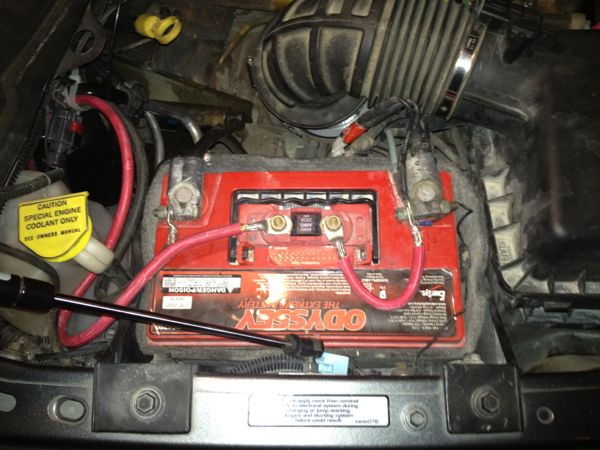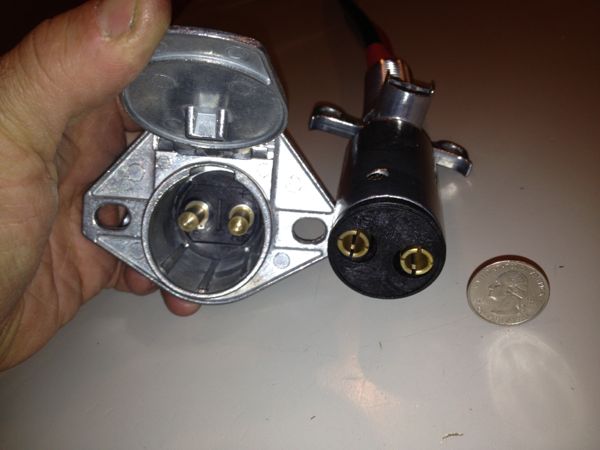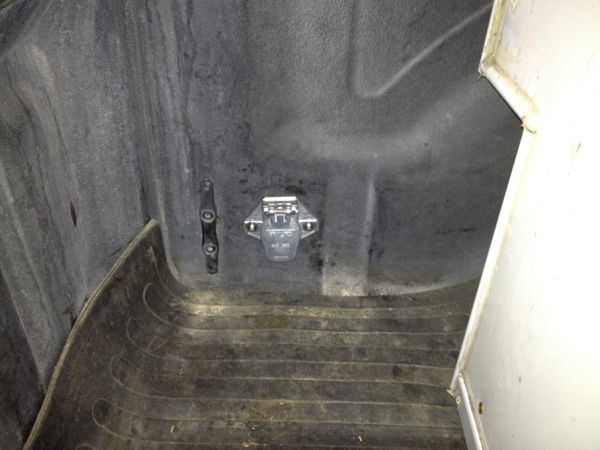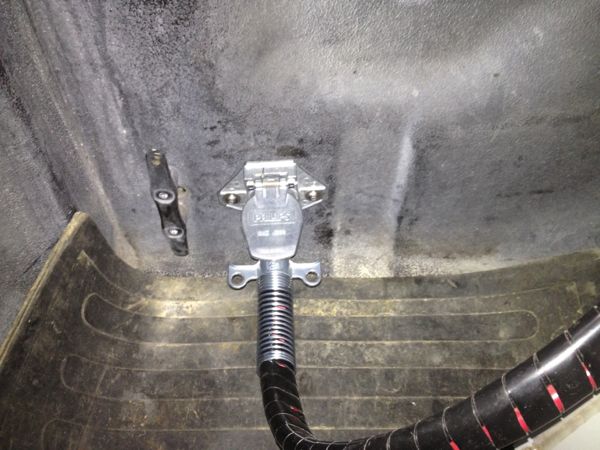- Good Sam Community
- Everything RV
- Technical Issues
- Direct Charge Circuit
- Subscribe to RSS Feed
- Mark Topic as New
- Mark Topic as Read
- Float this Topic for Current User
- Bookmark
- Subscribe
- Mute
- Printer Friendly Page
Direct Charge Circuit
- Mark as New
- Bookmark
- Subscribe
- Mute
- Subscribe to RSS Feed
- Permalink
- Report Inappropriate Content
Dec-12-2013 01:29 PM
- Mark as New
- Bookmark
- Subscribe
- Mute
- Subscribe to RSS Feed
- Permalink
- Report Inappropriate Content
Dec-14-2013 11:59 AM
Gjac wrote:Normal at the end of the drive. Initially the amps should have been higher. 6 amps would not be enough to immediately increase voltage from 12.4 to 13.8. But you are only down 30% so the charge will slow as you get above 80%. RJ is talking initial amps when the battery is way low. And if I know RJ he says 50% but they are probably even a little more discharged.
My MH is winterized now and 1200 mis away. But if I remember correctly after a week of dry camping my chassis batteries were depleted about 30% and the 2 6v house batteries were 50%. Voltage at house batteries were 14.1 v and house were at 13.7 or 13.8 v. On a 5 hr drive home at 60 mph I was reading about 5.5 amps going into the house batteries. Would a voltage drop of .3 v cause this?
Another good reason to have 200+ watts of solar going direct on the house battery.
- Mark as New
- Bookmark
- Subscribe
- Mute
- Subscribe to RSS Feed
- Permalink
- Report Inappropriate Content
Dec-14-2013 11:01 AM
Otherwise, as others have said, the largest practical wire size should be used between the engine battery or alternator and the RV batteries for direct connection together of all of them.
However just for information purposes, perhaps our Ford alternator setup is a bit different: When our RV batteries are way down, the alternator will provide 20-30 amps into the RV batteries over 6-8 feet of 6 gauge cables for several hours while driving. It may be that the 200 amp hours of discharged RV batteries reduces the overall voltage of the three batteries in parallel enough such that the alternator merely is sensing that a "large engine battery" is heavily discharged and hence needs this level of charging current.
- Mark as New
- Bookmark
- Subscribe
- Mute
- Subscribe to RSS Feed
- Permalink
- Report Inappropriate Content
Dec-14-2013 07:54 AM
A better alternative is to install an inverter in the engine compartment. Run a 120V ac cable to a small converter (like a 30A Iota IQ4) that's located next to the battery. This is guaranteed to work a lot better.
Sal
- Mark as New
- Bookmark
- Subscribe
- Mute
- Subscribe to RSS Feed
- Permalink
- Report Inappropriate Content
Dec-14-2013 04:20 AM
smkettner wrote:My MH is winterized now and 1200 mis away. But if I remember correctly after a week of dry camping my chassis batteries were depleted about 30% and the 2 6v house batteries were 50%. Voltage at house batteries were 14.1 v and house were at 13.7 or 13.8 v. On a 5 hr drive home at 60 mph I was reading about 5.5 amps going into the house batteries. Would a voltage drop of .3 v cause this?Gjac wrote:RJsfishin wrote:Rich can you describe how you achieved this rate of charging? I only see 5-6 amps of charge from a 180 amp alternator and 2 6 v batteries at 50% SOC.
Those trailer owners that think a full charged chassis battery won't let other paralleled batteries charge, are invited to look at my MH w/ an ammeter shunted right at the alternator. Yeah, that's what I have, and you'll see I constantly get a 60 amp charge to 50% discharged house batts, w/ a full charged chassis battery.
Easy. Measure the voltage at the alternator. Then measure at the 50% low GC2 batteries. Post the measurements.
Then trace along the path to find the voltage drop. Improve those areas until the amps start moving. You should aim for 0.2 to 0.4 voltage drop max between the alternator and house battery. The lower the voltage drop the better.
- Mark as New
- Bookmark
- Subscribe
- Mute
- Subscribe to RSS Feed
- Permalink
- Report Inappropriate Content
Dec-13-2013 08:22 PM
Our motorhome came with 6 gauge cabling built-in between it's Ford alternator and the two coach batteries. Of course, the engine battery is also connected to the alternator - so we have three 12V batteries all in parallel with each other getting charged by the Ford 130 amp alternator when going down the road.
I have a coach battery digital ammeter mounted right on the dash and I've seen the alternator dump up to 50 amps through the 6 gauge cabling into the coach batteries when the coach batteries were discharged but with the engine battery fully charged. Of course our 6 gauge cabling is probably only 6-8 feet long going from the alternator to the coach batteries.
- Mark as New
- Bookmark
- Subscribe
- Mute
- Subscribe to RSS Feed
- Permalink
- Report Inappropriate Content
Dec-13-2013 08:02 PM
04 Tail gator XT 34' 5th wheel garage model
200w solar 2 GC2's 800w inv
Truma tankless WH
99 F350 CC DRW 7.3 ais intake, adrenaline hpop, JW valve body,
cooling mist water inj, DP tunes, 4" exh sys
trucool trans cooler added
2011 RZR 900xp
- Mark as New
- Bookmark
- Subscribe
- Mute
- Subscribe to RSS Feed
- Permalink
- Report Inappropriate Content
Dec-13-2013 02:43 PM
Anderson Power Poles
1999 Winnebago Brave 35C F53 Chassis Solar power
Handicap Equipped with Lift & Hospital Bed
1999 Jeep Cherokee Sport
1991 Jeep Wrangler Renegade
- Mark as New
- Bookmark
- Subscribe
- Mute
- Subscribe to RSS Feed
- Permalink
- Report Inappropriate Content
Dec-13-2013 02:04 PM
Kountryguy wrote:
Has anyone done this project that could offer some suggestions on how to and what materials used? Any help will be appreciated.
I did exactly what you are describing; I ran a 2 gauge power and ground charge leads from my (180A) alternator/starting battery to the battery bank in my truck camper. I have seen charge current in excess of 100A @ 14.7V when the camper battery is deeply discharged. I installed a "lift-gate connector" in the truck bed to make the connection between my truck & camper. Of course there are fuses at both the truck and TC ends of the positive lead. In addition I have a volt/ammeter (w/shunt) in the truck cab to monitor charge voltage & current.
Note that I chose to use a high-current manual disconnect switch rather than a solenoid.
Photos below…
After seeing what I'd done, my father subsequently installed an identical setup between his Dodge Ram truck and Airstream TT…. I see no reason why the same couldn't be done with a 5th Wheel.
Cheers
-Mark





05 Ram3500, Cummins,Vision 19.5 w/M729F's, Dynatrac Hubs, RR airbags w/ping tanks, Superhitch, Roadmaster Swaybar, Rancho RS9000XL
The Overlhander Blog
- Mark as New
- Bookmark
- Subscribe
- Mute
- Subscribe to RSS Feed
- Permalink
- Report Inappropriate Content
Dec-13-2013 10:58 AM
Gjac wrote:RJsfishin wrote:Rich can you describe how you achieved this rate of charging? I only see 5-6 amps of charge from a 180 amp alternator and 2 6 v batteries at 50% SOC.
Those trailer owners that think a full charged chassis battery won't let other paralleled batteries charge, are invited to look at my MH w/ an ammeter shunted right at the alternator. Yeah, that's what I have, and you'll see I constantly get a 60 amp charge to 50% discharged house batts, w/ a full charged chassis battery.
Easy. Measure the voltage at the alternator. Then measure at the 50% low GC2 batteries. Post the measurements.
Then trace along the path to find the voltage drop. Improve those areas until the amps start moving. You should aim for 0.2 to 0.4 voltage drop max between the alternator and house battery. The lower the voltage drop the better.
- Mark as New
- Bookmark
- Subscribe
- Mute
- Subscribe to RSS Feed
- Permalink
- Report Inappropriate Content
Dec-13-2013 10:49 AM
RJsfishin wrote:Rich can you describe how you achieved this rate of charging? I only see 5-6 amps of charge from a 180 amp alternator and 2 6 v batteries at 50% SOC.
Those trailer owners that think a full charged chassis battery won't let other paralleled batteries charge, are invited to look at my MH w/ an ammeter shunted right at the alternator. Yeah, that's what I have, and you'll see I constantly get a 60 amp charge to 50% discharged house batts, w/ a full charged chassis battery.
- Mark as New
- Bookmark
- Subscribe
- Mute
- Subscribe to RSS Feed
- Permalink
- Report Inappropriate Content
Dec-13-2013 08:00 AM
1999 Winnebago Brave 35C F53 Chassis Solar power
Handicap Equipped with Lift & Hospital Bed
1999 Jeep Cherokee Sport
1991 Jeep Wrangler Renegade
- Mark as New
- Bookmark
- Subscribe
- Mute
- Subscribe to RSS Feed
- Permalink
- Report Inappropriate Content
Dec-13-2013 07:38 AM
'01 31' Rexall Vision, Generac 5.5k, 1000 watt Honda, PD 9245 conv, 300 watts Solar, 150 watt inv, 2 Cos 6v batts, ammeters, led voltmeters all over the place, KD/sat, 2 Oly Cat heaters w/ ox, and towing a 2012 Liberty, Lowe bass boat, or a Kawi Mule.
- Mark as New
- Bookmark
- Subscribe
- Mute
- Subscribe to RSS Feed
- Permalink
- Report Inappropriate Content
Dec-13-2013 07:11 AM
Camper_Jeff_&_Kelli wrote:Matthew_B wrote:
I'd like to make a request to have a separate TCU sticky thread on upgraded charging systems. I've posted about my system in my camper mod page, and there are a couple of other threads floating around about doing the same thing. This topic comes up often enough that it seem like a good idea to have a tread with one stop info on people's various systems.
I'll start with a repost of my setup, and I invite those in the 6 gauge, 4 gauge or 2 gauge club to join in.
I listed a few choice threads that were pertinent at the time I was doing my upgrade project research.
Links are halfway down the page and as the post goes on, there are references to other threads as th...
Here are a couple links to other threads that have been of great help doing this project.
Matthew_B, Alternator Charge Cable Installation to TC.
BC Sierra, Alternator Charge Cable Installation to TC.
JoeChiOhki, Power Converter Thread.
Battery Discussion Thread
Battery Warmer Thread by Sleepy
My earlier discussion thread.
My original post relating to installing large 4 gauge wire.
This is the first thread with a report on charge cable performance.
J
Original thread - go to end
Although I suggest going with 200w to 500w of solar on the trailer roof. Solar works when camped and while in transit as long as there is sun.
- Mark as New
- Bookmark
- Subscribe
- Mute
- Subscribe to RSS Feed
- Permalink
- Report Inappropriate Content
Dec-13-2013 04:21 AM
2016 Silverado 3500HD DRW D/A 4x4
2018 Keystone Cougar 26RBS
2006 Weekend Warrior FK1900





